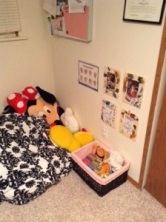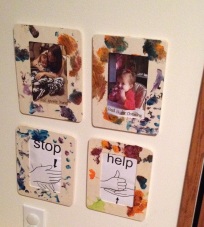Cozy areas at home
One of the most common questions I have from parents during conferences is the topic of guidance. Often times, I share with families various techniques and ways for families to adopt these new techniques at home. I not only use these techniques with families and in my classroom, but I also use these same techniques at home. I have the pleasure of being a mom to a one and a half-year old. As my daughter started nearing her first birthday I knew I wanted to use all of the techniques I had learned over my teaching career with her. One of the most important ideas I knew I wanted to recreate at home was a cozy area.
When a child is older we encourage the child to be a part of setting this whole process up as much as possible. I began to reflect about how could my daughter be a part of this process at such a young age. I completely believe that I am building her a foundation for self-regulation and understanding of her own feelings, but also knew that I would have to present the materials and techniques in a different manner than I would with older children. I began the process of creating a cozy area at home by purchasing frames that she could paint on that wood. She decorated four frames. Two frames have sign language (we are teaching her sign language) stop and help. The other two have two house rules we made. We then added soft items to the area including a large stuffed animal, a small pillow, and a large pillow covered in a soft blanket. Beside the pictures are emotion faces. When an incident occurs, we point out the emotion and sign the emotion word as well. Under all of this is a basket with feelings books , two stuffed animals, and my daughters “blankie”.
As we began to set up the area we added a few items at a time so that our daughter could explore each of the items before it was all ready. We then did a lot of teaching about the items as they were added. We also did some role-playing as well. Once it was officially set up we began to use it. Any time our daughter was upset we would offer the opportunity to go into that area to as we call it “calm your body”. We continued this for several weeks and she would start to use it even when she was scared of loud sounds. We have now had our area up for about four months. She uses it often and also encourages her stuffed animals and me and my husband to use it as well. When she comes out from calming her body we ask her if she is ready sometimes she will say no and returning by herself to her cozy area. When she is ready she returns and we talk about whatever the reason that sent her to the cozy area. We might be talking about scary noises, feeling over excited, feeling mad, and/or sad. Below are pictures of ours cozy area.
 If you have created a cozy area at home, tell us about it. What worked? Didn’t work? What questions do you have?
If you have created a cozy area at home, tell us about it. What worked? Didn’t work? What questions do you have?
